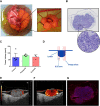Noninvasive Contrast-Free 3D Evaluation of Tumor Angiogenesis with Ultrasensitive Ultrasound Microvessel Imaging
- PMID: 30894634
- PMCID: PMC6426859
- DOI: 10.1038/s41598-019-41373-0
Noninvasive Contrast-Free 3D Evaluation of Tumor Angiogenesis with Ultrasensitive Ultrasound Microvessel Imaging
Abstract
Ultrasound microvessel imaging (UMI), when applied with ultrafast planewave acquisitions, has demonstrated superior blood signal sensitivity in comparison to conventional Doppler imaging. Here we propose a high spatial resolution and ultra-sensitive UMI that is based on conventional line-by-line high-frequency ultrasound imagers and singular value decomposition (SVD) clutter filtering for the visualization and quantification of tumor microvasculature and perfusion. The technique was applied to a chicken embryo tumor model of renal cell carcinoma that was treated with two FDA-approved anti-angiogenic agents at clinically relevant dosages. We demonstrate the feasibility of 3D evaluation with UMI to achieve highly sensitive detection of microvasculature using conventional line-by-line ultrasound imaging on a preclinical and commercially available high-frequency ultrasound device without software or hardware modifications. Quantitative parameters (vascularization index and fractional moving blood volume) derived from UMI images provide significantly improved evaluation of anti-angiogenic therapy response as compared with conventional power Doppler imaging, using histological analysis and immunohistochemistry as the reference standard. This proof-of-concept study demonstrates that high-frequency UMI is a low-cost, contrast-agent-free, easily applicable, accessible, and quantitative imaging tool for tumor characterization, which may be very useful for preclinical evaluation and longitudinal monitoring of anti-cancer treatment.
Conflict of interest statement
The authors declare no competing interests.
Figures




Similar articles
-
Improved Ultrasound Microvessel Imaging Using Deconvolution with Total Variation Regularization.Ultrasound Med Biol. 2021 Apr;47(4):1089-1098. doi: 10.1016/j.ultrasmedbio.2020.12.025. Epub 2021 Jan 16. Ultrasound Med Biol. 2021. PMID: 33468358 Free PMC article.
-
Inactivation of endothelial cell phosphoinositide 3-kinase β inhibits tumor angiogenesis and tumor growth.Oncogene. 2020 Oct;39(41):6480-6492. doi: 10.1038/s41388-020-01444-3. Epub 2020 Sep 2. Oncogene. 2020. PMID: 32879446
-
Debiasing-Based Noise Suppression for Ultrafast Ultrasound Microvessel Imaging.IEEE Trans Ultrason Ferroelectr Freq Control. 2019 Aug;66(8):1281-1291. doi: 10.1109/TUFFC.2019.2918180. Epub 2019 May 22. IEEE Trans Ultrason Ferroelectr Freq Control. 2019. PMID: 31135357 Free PMC article.
-
Optimizing treatment of renal cell carcinoma with VEGFR-TKIs: a comparison of clinical pharmacology and drug-drug interactions of anti-angiogenic drugs.Cancer Treat Rev. 2020 Mar;84:101966. doi: 10.1016/j.ctrv.2020.101966. Epub 2020 Jan 17. Cancer Treat Rev. 2020. PMID: 32044644 Review.
-
Predictive biomarkers in renal cell cancer: insights in drug resistance mechanisms.Drug Resist Updat. 2014 Oct-Dec;17(4-6):77-88. doi: 10.1016/j.drup.2014.10.003. Epub 2014 Oct 7. Drug Resist Updat. 2014. PMID: 25457974 Review.
Cited by
-
Super-Resolution Imaging with Ultrasound for Visualization of the Renal Microvasculature in Rats Before and After Renal Ischemia: A Pilot Study.Diagnostics (Basel). 2020 Oct 22;10(11):862. doi: 10.3390/diagnostics10110862. Diagnostics (Basel). 2020. PMID: 33105888 Free PMC article.
-
Short Acquisition Time Super-Resolution Ultrasound Microvessel Imaging via Microbubble Separation.Sci Rep. 2020 Apr 7;10(1):6007. doi: 10.1038/s41598-020-62898-9. Sci Rep. 2020. PMID: 32265457 Free PMC article.
-
Dietary tomato inhibits angiogenesis in TRAMP prostate cancer but is not protective with a Western-style diet in this pilot study.Sci Rep. 2021 Sep 17;11(1):18548. doi: 10.1038/s41598-021-97539-2. Sci Rep. 2021. PMID: 34535690 Free PMC article.
-
Micro-ultrasound based characterization of cerebrovasculature following focal ischemic stroke and upon short-term rehabilitation.J Cereb Blood Flow Metab. 2024 Apr;44(4):461-476. doi: 10.1177/0271678X231215004. Epub 2023 Nov 16. J Cereb Blood Flow Metab. 2024. PMID: 37974304 Free PMC article.
-
Improved Ultrasound Microvessel Imaging Using Deconvolution with Total Variation Regularization.Ultrasound Med Biol. 2021 Apr;47(4):1089-1098. doi: 10.1016/j.ultrasmedbio.2020.12.025. Epub 2021 Jan 16. Ultrasound Med Biol. 2021. PMID: 33468358 Free PMC article.
References
Publication types
MeSH terms
Substances
Grants and funding
LinkOut - more resources
Full Text Sources
Medical

